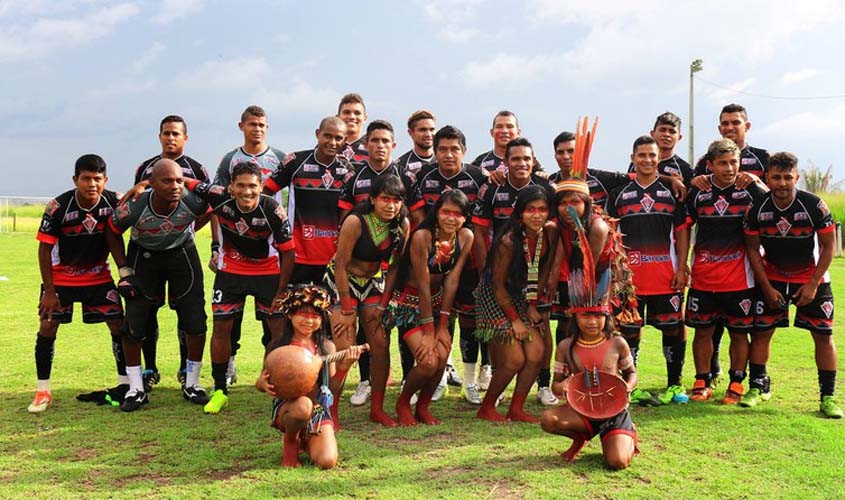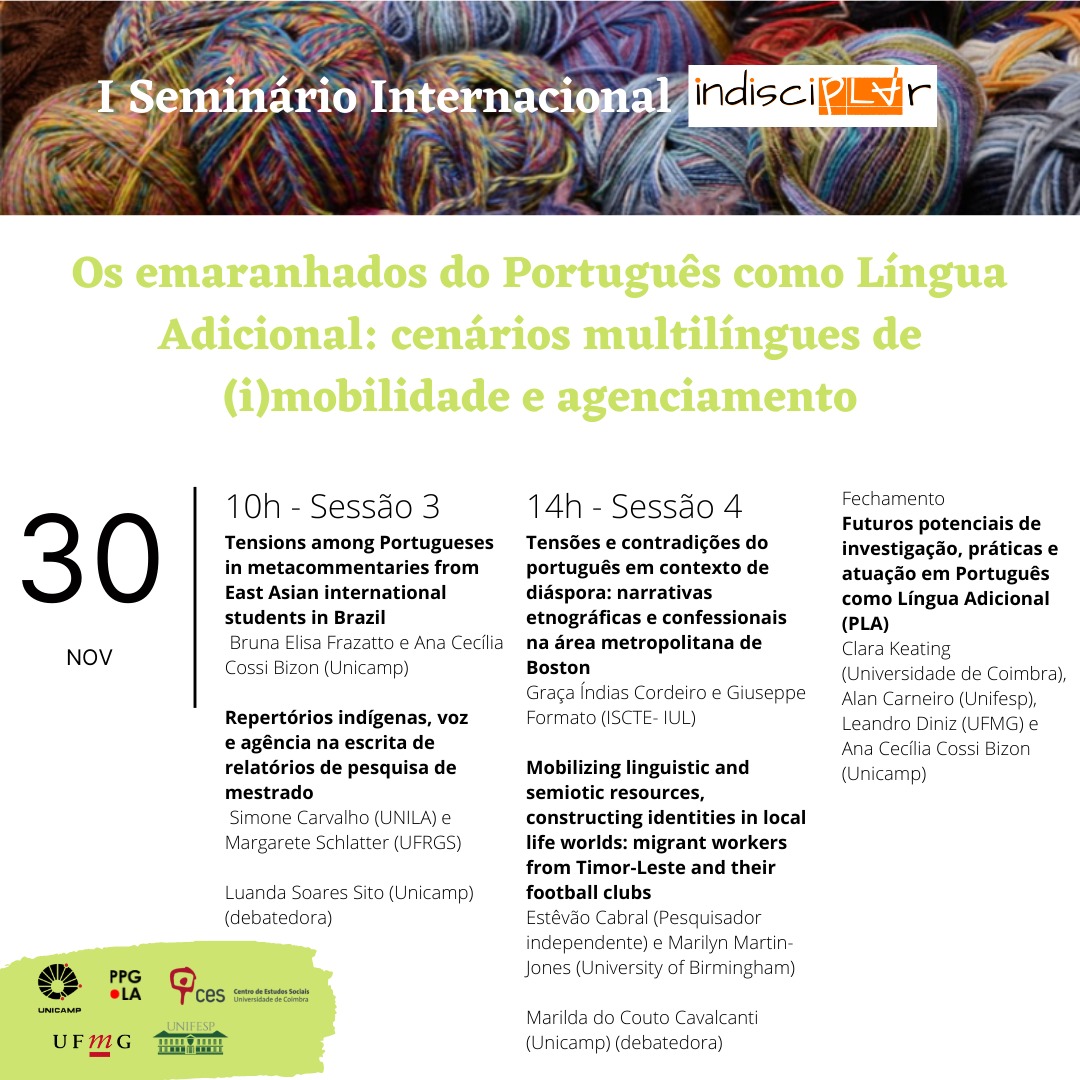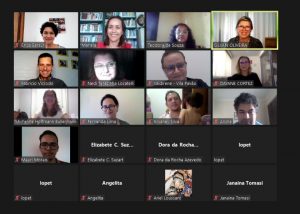II Seminário Internacional Viva Língua Viva é sediado na UFPA com participação de 29 etnias indígenas

Alexandre de Moraes – Ascom UFPA
O II Seminário Internacional Viva Língua Viva ocorreu na Universidade Federal do Pará (UFPA), de 22 a 25 de novembro, em parceria com o Museu Paraense Emílio Goeldi (MPEG) e a Associação Brasileira de Linguística (Abralin). O evento teve como tema “Revitalização de Línguas: Por que e como fazer?” e também aludiu à Década Internacional das Línguas Indígenas (IDIL 2022-2023), proclamada pela Assembleia Geral das Nações Unidas, com o objetivo de chamar a atenção mundial sobre a situação crítica de muitas línguas indígenas e mobilizar recursos para a sua preservação, revitalização e divulgação.

Alexandre de Moraes – Ascom UFPA
A abertura do seminário teve a participação do reitor da UFPA, Emmanuel Zagury Tourinho; do prefeito de Belém em exercício, Edilson Moura; da presidente da Abralin, Adelaide Silva; da diretora do Instituto de Letras e Comunicação (ILC) da UFPA, professora Tânia Sarmento-Pantoja; do linguista e diretor da área de Ciências Humanas do MPEG, Hein van der Voort; da diretora da área de Linguística e Literatura da Capes e diretora de pesquisa da UFPA, professora Germana Sales; da coordenadora do Programa de Pós-Graduação em Letras (PPGL) da UFPA, professora Ivânia Neves; e da presidente da comissão organizadora do evento, professora Ana Vilaci Galúcio.
Também participaram da abertura a pró-reitora de Ensino de Graduação da UFPA, professora da área de Linguística Marília Ferreira; a diretora geral da Secretaria Municipal de Educação (Semec), professora Araceli Lemos; bem como a ouvidora do município de Belém e doutoranda da UFPA Márcia Kambeba, que realizou um canto de saudação inicial, em língua indígena, para celebrar o encontro com os parentes.

Alexandre de Moraes – Ascom UFPA
Na sequência, a mestranda Veraneize dos Anjos, da etnia Arapium, representando os indígenas da região do Baixo Tapajós, abordou o tema “Por que e como fazer a preservação da língua Nhengatu”, conhecida como língua geral amazônica ou tupi moderno, pertencente à família tupi-guarani, sendo então derivada do tronco tupi.
O evento teve a participação de indígenas representantes de 29 etnias de todo o Brasil, entre as quais, os Terena, Kaingang, Apalai, Baniwa, Tembé, Rikbaktsa, Manoki, Galibi, Kali’na, Apurinã, Macuxi, Tapirapé, Galibi-Marworno, Ãwa Ikpeng, Kokama, Karajá, Xakriabá, Puroborá, Kadiweu, Puri, Karipuna, Sakuarabiat, Awa, Guajá, Mÿky. Entre estudantes de graduação, pós-graduação e também docentes em Instituições de Ensino Superior, os indígenas participaram como público, oficineiros(as) e ministrantes do seminário.

Alexandre de Moraes – Ascom UFPA
Celebração – A coordenadora do evento, Ana Vilaci Galúcio, iniciou os pronunciamentos de abertura do evento afirmando que a razão de ser do seminário, em sua segunda edição, é justamente a celebração da língua dos povos originários. Ela recordou que o primeiro seminário foi realizado no Rio de Janeiro, em 2019, e destacou o quão é importante que, desta vez, o evento esteja sendo sediado na Amazônia, em Belém. “Estamos aqui para aprender e trocar experiências sobre a revitalização das línguas indígenas, somando esforços à década em que refletimos, no mundo, sobre o tema ‘Nada para nós sem nós’. Que possamos estar na linha de frente para reverter silenciamentos”, afirmou.
A professora Ivânia Neves, representando o PPGL UFPA, pontuou que a realização de um evento como o Viva a Língua Viva era inimaginável há alguns anos e que o seminário vem ressaltar a importância da universidade pública para o resgate da história e do protagonismo indígena no país. Para ela, o fato de hoje existirem alunos e professores indígenas em uma universidade é, por si só, uma revolução e, ao mesmo tempo, uma dívida. “Antes da colonização, Belém era território Tupinambá, terra de Maíra, do povo Maíri, do rio Guamá”, lembrou.

Alexandre de Moraes – Ascom UFPA
A coordenadora da área de Linguística e Literatura da Capes, Germana Sales, abordou a mitificação dos povos indígenas na literatura mundial, sendo de extrema importância recuperar, sem nuances, o lugar que é a eles devido na história da colonização, tendo sido historicamente silenciados pela barbárie, a escravidão e o genocídio. Na mesma linha de pensamento, o linguista representante do Museu Goeldi, Hein van der Voort, lembrou que, como consequência disso, muitas línguas indígenas encontram-se em risco de extinção, o que significa que seus falantes, da mesma forma, permanecem ameaçados, sendo, portanto, importante resistir.

Alexandre de Moraes – Ascom UFPA
Resistência – A resistência foi o cerne da fala da diretora do ILC UFPA, Tânia Sarmento, para quem o evento é extremamente necessário para a reparação histórica do que têm passado os povos originários no Brasil, sendo a produção científica sobre suas línguas uma das formas de manter viva as suas culturas e identidades. A presidente da Abralin, Adelaide Silva, concordou em dizer que um dos fatores pelos quais a Associação apoia a realização do evento é o de devolver o protagonismo da pesquisa na área aos próprios povos e falantes das línguas indígenas.
O prefeito em exercício de Belém, Edilson Moura, afirmou que a preservação das línguas indígenas é muito importante para preservar a própria cultura que resulta na diversidade sociocultural amazônica, tendo sido a UFPA uma das instituições que vêm permanentemente se esforçando, ainda que em contexto nacional de muitas dificuldades e negacionismos, para manter a ciência em movimento.

Alexandre de Moraes – Ascom UFPA
Diversidade – Para o reitor Emmanuel Tourinho, essa tarefa somente é possível por meio de parcerias como a estabelecida com o MPEG e a Abralin para a realização do seminário. Atualmente, por intermédio da política de reserva de vagas, a UFPA possui ativos cerca de 500 estudantes indígenas, além de mais de três mil alunos(as) quilombolas, bem como ribeirinhos(as) e oriundos de comunidades extrativistas, além de migrantes como os da etnia Warao, venezuelanos, aprovados por meio de processos seletivos especiais.
“Temos somado esforços para acolher, na instituição, a diversidade dos povos da Amazônia, na expectativa de que, cada vez mais, a UFPA tenha a cara da nossa sociedade. Somente um ambiente intelectual diverso pode oferecer debates que levem a soluções para os grandes desafios da região amazônica. Ouvir os povos originários é fundamental para uma universidade comprometida com o futuro da Amazônia”, afirmou.
Programação – O II Seminário Internacional Viva Língua Viva seguiu até sexta, 25 de novembro, com atividades realizadas em diversos espaços do Campus UFPA – Guamá. O evento contou com conferências, mesas-redondas, rodas de conversa, oficinas, sessões de comunicações e sessões de pôster, programações culturais, entre outras. A programação completa está disponível no site do evento: https://viva.abralin.org/eventos/viva-lingua-viva-22/.
FONTE: Ascom UFPA
Conheça o 1° time indígena de futebol do Brasil
O time representa a etnia Kyikatejê que, na língua Timbira Oriental, significa “povo do rio acima”

Foto: Magno Barros/Oficial Gaviões Kyikatêjê
Neste especial Copa do Mundo, a Fundação Nacional do Índio (Funai) apresenta fatos e curiosidades sobre indígenas e etnias que apresentam relação com o futebol. Fundado na década de 1980 no estado do Pará, o Futebol Clube Gavião Kyikatêjê foi o primeiro time profissional de futebol registrado entre os indígenas.
O time representa a etnia Kyikatejê que, na língua Timbira Oriental, significa “povo do rio acima”. O clube fica localizado no município de Bom Jesus do Tocantins, a pouco mais de 450 quilômetros de Belém, capital do Pará. A iniciativa logo chamou atenção por sua principal característica: a raiz indígena, com destaque em ser o primeiro time de uma etnia tradicional a disputar a divisão principal de um campeonato profissional estadual no ano de 2014.
Seu ex-treinador, Zeca Gavião, além de ser presidente do time, tornou-se ainda o primeiro indígena a comandar um clube do país. Anteriormente, o grupo era formado totalmente por indígenas e, atualmente, é um time misto.
O Gavião Kyikatêjê chamou tanta atenção por sua diversidade cultural que, em 2017, a Federação Internacional de Futebol (Fifa), entidade máxima do futebol mundial, produziu um documentário sobre a história do clube indígena, como forma de homenagear os indígenas pela iniciativa. Clique aqui para assistir o vídeo da Fifa.
Em 2022, o clube disputa a Série B do Campeonato Estadual Paraense.
I Seminário Internacional IndisciPLAr: “Os emaranhados do Português como Língua Adicional: cenários multilíngues de (i)mobilidade e agenciamento”
A programação completa encontra-se nas imagens abaixo.


Inscrições pelo link: https://forms.gle/43W9iEN6rAyqnGiz8
Data: 29 e 30 de novembro
Local: Sala de Videoconferência do Centro Cultural – IEL/UNICAMP e canal do IEL no YouTube (evento híbrido)
Lei que cria a “Semana Cultural dos Povos Indígenas” foi sancionada em Rondônia
Semana Cultural dos Povos Indígenas que abordará a realidade dos povos originários

Nesta semana foi sancionada pelo governo de Rondônia, a Lei n° 5.452/22 aprovada na Assembleia Legislativa do Estado – ALE/RO, que cria a Semana Cultural dos Povos Indígenas. A iniciativa regulamenta em seus oito artigos, a conscientização quanto à importância da cultura e a preservação da memória dos povos que originariamente habitam o Estado de Rondônia.
A diversidade de povos indígenas presentes em toda a região Norte do Brasil e em grande número no Estado de Rondônia tem levado as autoridades locais a potencializarem políticas para desenvolver este seguimento da sociedade brasileira. Em apontamentos de lideranças indígenas, os últimos quatro anos têm sido proveitosos em ações quanto aos cumprimentos de objetivos constitucionais, em especial, o Inciso IV do Artigo 3° – promover o bem de todos, sem preconceitos de origem, raça, sexo, cor, idade e quaisquer outras formas de discriminação.
A legislação que cria a agenda de debates sobre a valorização do indígena, marca a entrada no Calendário Oficial do Estado de Rondônia das comemorações, que anualmente acontecerão entre os dias 18 a 21 de abril.
As mais de 54 etnias de Rondônia, segundo dados da Secretaria de Estado do Desenvolvimento Ambiental – Sedam, que têm usufruto das terras da União dentro das divisas rondonienses, para desenvolverem atividades econômicas com sustentabilidade têm se beneficiado de políticas do órgão. Uma das articuladoras é a Coordenadoria de Povos Indígenas – Copin, que submete propostas e projetos que possam garantir a geração de renda de forma sustentável nos territórios indígenas.
A inferência que a Semana Cultural dos Povos Indígenas faz em sua Lei, referente à desconstrução destes povos, é para o professor e pesquisador Alécio Valois, coordenador de Patrimônio do Estado de Rondônia – Sejucel, a síntese da motivação pública de defesa deste seguimento de população. “Estes dias de eventos anuais serão uma oportunidade para os indígenas falarem sobre sua realidade, além disso, professores e pesquisadores de diversas etnias compartilharão suas experiências”, pontuou Alécio.
PROCESSO HISTÓRICO
A desconstrução da visão preconceituosa frente à temática indígena, segundo o coordenador da Sejucel, só pode ter êxito se houver uma um olhar de todos os cidadãos sobre a realidade. “Somente assim poderemos ter uma sociedade mais tolerante, mais solidária e mais fraternal ”, contribuiu Alécio Valois.
O coordenador explica, ainda, a face de interculturalidade dos eventos oficiais da semana, de modo que profissionais de diversas áreas de conhecimento, bem como história, direito, entre outros, podem pormenorizar a visão de quem tem raízes indígenas e desenvolve suas atividades junto à sociedade. “Este estímulo cria uma relação intercultural que incentiva não indígenas a visitarem reservas indígenas sem a visão do índio do ano de 2022, não do índio de 1.500”, reconheceu Valois.
IDENTIDADE
Em comparação aos pesos e medidas nos quais a sociedade brasileira acostumou-se, Alécio relacionou o preconceito, no qual os grupos de Movimentos dos Sem Terra – MST sofrem por invadirem propriedades privadas, porém não há o mesmo rigor quanto sociedade frente à defesa indigenista. “Parte de nossos ancestrais, não indígenas invadiram terras que já eram ocupadas, então somos sem terra também, mas a maioria da sociedade não se olha como tal”, salientou.
O representante e conselheiro titular do Setorial Indígena de Rondônia, Welington R. Cinta Larga, emocionou-se ao comemorar a quebra de paradigma que a nova Lei vem proporcionar. “É gratificante saber que vamos ter a oportunidade de mostrar nossa cultura, nossa arte e mostrar para indígenas e não indígenas que nós estamos aqui”, declarou. Para ele, se a legislação permanecer será um fortalecimento à origem e cultura do País.
A Constituição Federal de 1988 possui o Capítulo VIII, exclusivo com dois artigos que versam sobre a defesa dos índios e seu reconhecimento apresentando uma organização social, costumes, línguas, crenças e tradições. No Censo do IBGE de 2010, o Brasil possuía 817.963 índios, dos quais aproximadamente 62% vivem em áreas rurais.
FONTE:




